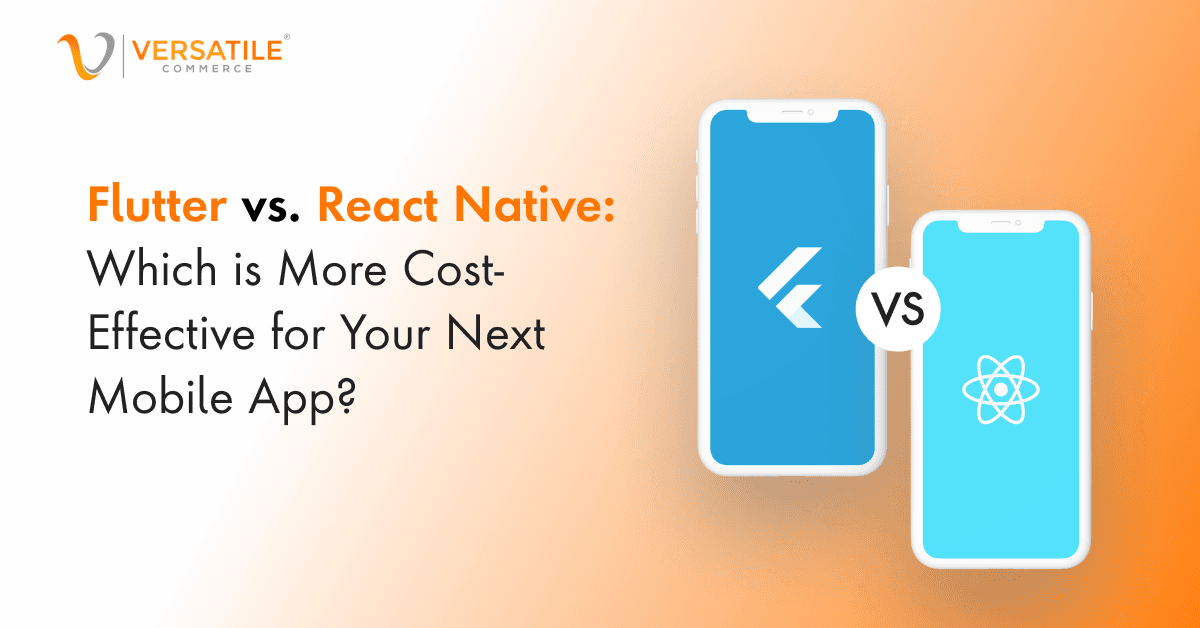
With over 6.3 billion smartphone users globally, businesses are under increasing pressure to deliver seamless, scalable, and cost-effective mobile solutions in a rapid way. In such a competitive landscape, streamlining your mobile application development process is no longer optional; it’s a strategic necessity.
As companies navigate this mobile-first reality, the choice between two leading cross-platform app development frameworks, Flutter and React Native, has become a pivotal strategic decision. While both frameworks promise faster time-to-market, code reusability, and native-like performance, they diverge significantly when scrutinised through the lens of cost-effectiveness.
Explore the critical cost drivers, including development speed, talent availability, long-term maintenance, and performance trade-offs. If you’re aiming to reduce development overhead while scaling user experience across platforms, this side-by-side analysis will empower you to make an informed, cost-conscious technology choice.
1. Why Cross-Platform Mobile Development Is Dominating 2025
As mobile usage continues to scale at unprecedented heights, the global digital economy is undergoing a profound transformation. Businesses today are no longer asking if they need a mobile app but how fast they can deploy one, how well it performs across platforms, and how cost-effectively it can be built and maintained.
This demand has paved the way for cross-platform frameworks to emerge as the cornerstone of modern app development. Statista projects that the global cross-platform app market will reach $546 billion by 2026, underscoring the urgent need for agile, scalable, and budget-conscious development methodologies.
As we already discussed, among the contenders, Flutter and React Native have emerged as dominant players. They offer the ability to build apps for iOS and Android using a single codebase. This dual-platform capability significantly reduces time-to-market and development costs, making both frameworks a compelling proposition for startups and enterprises alike.
Yet, while both options promise efficiency, the underlying cost structures, ranging from developer availability to maintenance overhead, differ meaningfully. The choice between them isn't merely a technical preference but a strategic business decision directly impacting long-term ROI.
2. Flutter vs. React Native: A Technical and Market Overview
Beyond the shared value proposition, these frameworks offer distinct capabilities that influence everything from user experience to long-term scalability.
2.1. Flutter: Google’s UI Powerhouse
Developed by Google and powered by the Dart programming language, Flutter has seen exponential adoption due to its powerful rendering engine and expressive UI capabilities. As of 2023, over 500,000 Flutter apps have been published on the Google Play Store, a testament to its growing footprint in the developer community.
Key highlights include:
Native performance using its own Skia graphics engine, bypassing OEM widgets for a consistent look across platforms.
Rich widget libraries and a reactive programming model for high-fidelity UI experiences.
Strong support for Material Design and Cupertino, enabling brand-consistent apps across Android and iOS.
Backed by a robust ecosystem including Firebase, making it ideal for scalable MVPs and full-fledged apps alike.
2.2. React Native: JavaScript-Led Efficiency
Created and maintained by Meta (formerly Facebook), React Native leverages JavaScript and React to build mobile apps with near-native performance. In 2023, 35% of software developers reported using React Native, making it one of the most adopted frameworks in the mobile development space.
Key advantages include:
Large talent pool and strong community support, resulting in faster onboarding and reduced hiring costs.
Hot reloading and seamless integration with existing web-based tech stacks.
Modular architecture, allowing efficient updates and component reuse.
3. Cost Analysis Parameters: What Truly Impacts Your Bottom Line

3.1. Development Time & Productivity
The speed of development plays a direct role in shaping overall project cost. Flutter offers a streamlined development experience with its expressive UI toolkit and a single codebase that extends even to platform-specific UI elements. This makes it especially advantageous for visually rich and brand-sensitive applications. In contrast, React Native, built on JavaScript and React, benefits from an extensive developer base and faster prototyping, especially for web-to-mobile migrations. However, it may require additional time for native integrations as app complexity increases. In practical terms, Flutter app development cost can be lower for design-heavy projects due to reduced UI iteration cycles, while React Native development cost tends to favour MVPs and startups aiming for rapid deployment.
3.2. Talent Availability and Hiring Cost
A major driver of mobile development cost is developer availability. React Native enjoys a significant advantage in this space, thanks to JavaScript’s global dominance. This results in a broader talent pool, reduced hiring lead times, and lower salary premiums, especially in emerging markets. Conversely, while Flutter's developer community is growing at an impressive pace, it remains comparatively niche, which can drive up resource costs and onboarding efforts. As such, businesses may experience a more predictable React Native development cost structure when scaling teams, whereas Flutter app development cost may be influenced by talent scarcity in some regions.
3.3. Code Reusability and Maintenance
Both Flutter and React Native promote high code reusability, but the extent varies. Flutter's architecture enables near-total reuse, including UI components, across platforms, resulting in fewer platform-specific exceptions and streamlined maintenance cycles. This translates into reduced long-term costs, particularly for apps that need consistent UI/UX across Android and iOS. React Native, while also built for reusability, often requires more native bridging and conditional logic for complex functionalities, which can elevate maintenance overhead. In this context, Flutter app development cost is often more predictable over time, while React Native development cost may increase as the app scales and diversifies.
3.4. Third-Party Libraries and Ecosystem Maturity
React Native holds a first-mover advantage with a mature ecosystem and a rich array of third-party libraries. This enables faster implementation of common functionalities, reducing the need for custom development and lowering upfront costs. Flutter, though newer, has made commendable progress in expanding its plugin library but may still fall short in highly specialised use cases. This can lead to additional time spent building custom solutions, marginally raising the Flutter app development cost. In contrast, the established ecosystem surrounding React Native offers significant leverage in minimising overall React Native development cost, especially in early-stage projects.
3.5. Performance and Optimization Costs
Performance optimization is an often-overlooked aspect of development budgets. Flutter’s custom rendering engine allows for consistently high frame rates and native-level animations across devices, which reduces the need for costly post-launch optimization. React Native apps, on the other hand, generally achieve 50–55 FPS, which may be sufficient for standard apps but can cause noticeable jank in animation-heavy or complex interfaces. This inconsistency may necessitate additional QA cycles and performance tuning, which impacts total cost. From this standpoint, Flutter app development cost includes fewer post-deployment adjustments, while React Native development cost may escalate during performance-critical stages.
4.Total Cost of Ownership (TCO) Comparison
To assist decision-makers in evaluating the budgetary impact of their technology choice, we’ve consolidated key cost factors into a comprehensive side-by-side comparison. From initial development outlay to long-term maintenance expenses, the following snapshot provides a high-level view of how Flutter app development cost stacks up against React Native development cost across critical dimensions. This quick-reference table is designed to complement your strategic review and guide to capital allocation based on project goals, timeline pressures, and scalability needs.
TCO Comparison | ||
Parameter | Flutter | React Native |
Development Time | Shorter due to unified codebase | Moderate; may need platform-specific adjustments |
Developer Rates | Potentially higher due to demand | Generally competitive due to larger talent pool |
Maintenance Costs | Lower; fewer runtime issues | Higher; frequent updates and debugging |
Performance | High; consistent across platforms | Near-native; may vary with complexity |
Community Support | Growing rapidly | Extensive and established |
Choosing between Flutter and React Native isn't just about features or costs; it’s about aligning your framework choice with the specific business use case, product complexity, user expectations, UI consistency, and time-to-market objectives. Both platforms are capable, but they excel in different scenarios. Below is a breakdown of when to leverage each based on industry demands, app characteristics, and strategic goals.
5.1. When Flutter Is the Right Fit
Flutter’s biggest strength lies in its ability to render consistent, high-performance UIs across devices with minimal platform-specific adjustments. This makes it ideal for businesses that prioritise design fidelity, brand consistency, and superior animations.
Best use cases for Flutter:
FinTech and Banking Apps: Where security, seamless design, and performance under load are non-negotiable.
On-demand and Delivery Apps: Due to Flutter’s ability to manage real-time updates and GPS integrations effectively.
Healthcare and MedTech Platforms: That demand high UX consistency across patient and practitioner interfaces.
Startups building scalable MVPs: Where time is short, but visual polish and responsiveness matter.
IoT or Embedded UI Apps: Thanks to its rendering engine, Flutter is increasingly used in device-specific UI layers.
5.2. When React Native Takes the Lead
React Native is a pragmatic choice for web-heavy businesses, enterprises with existing JavaScript teams, or companies needing rapid deployment without deep UI customisation. Its ecosystem supports fast iteration, easier team onboarding, and broad plugin support.
Best use cases for React Native:
eCommerce and Retail Apps: Where integration with CMS, CRM, or marketing platforms is critical and development speed is key.
Social media or Content-Based Platforms: That leverage real-time feeds and benefit from JS-based agility.
Enterprise Mobility Apps: Especially internal tools or dashboards with moderate UI requirements.
Media and Entertainment Applications: That rely heavily on dynamic content delivery and push notifications.
Cross-platform MVPs with tight budgets: Ideal when reusing web-based logic across mobile platforms.
6.Conclusion: Make the Right Investment for Long-Term Gains
The decision between Flutter and React Native is not simply a matter of technical preference; it’s a strategic business choice that can influence cost-efficiency, time-to-market, and user satisfaction. Both frameworks offer robust capabilities for cross-platform mobile development, but the difference lies in their strengths, trade-offs, and alignment with specific business objectives.
Ready to transform your mobile strategy into a scalable success story?
Partner with Versatile Commerce to build high-performance apps with Flutter or React Native that will be delivered on time, on budget, and on brand.



